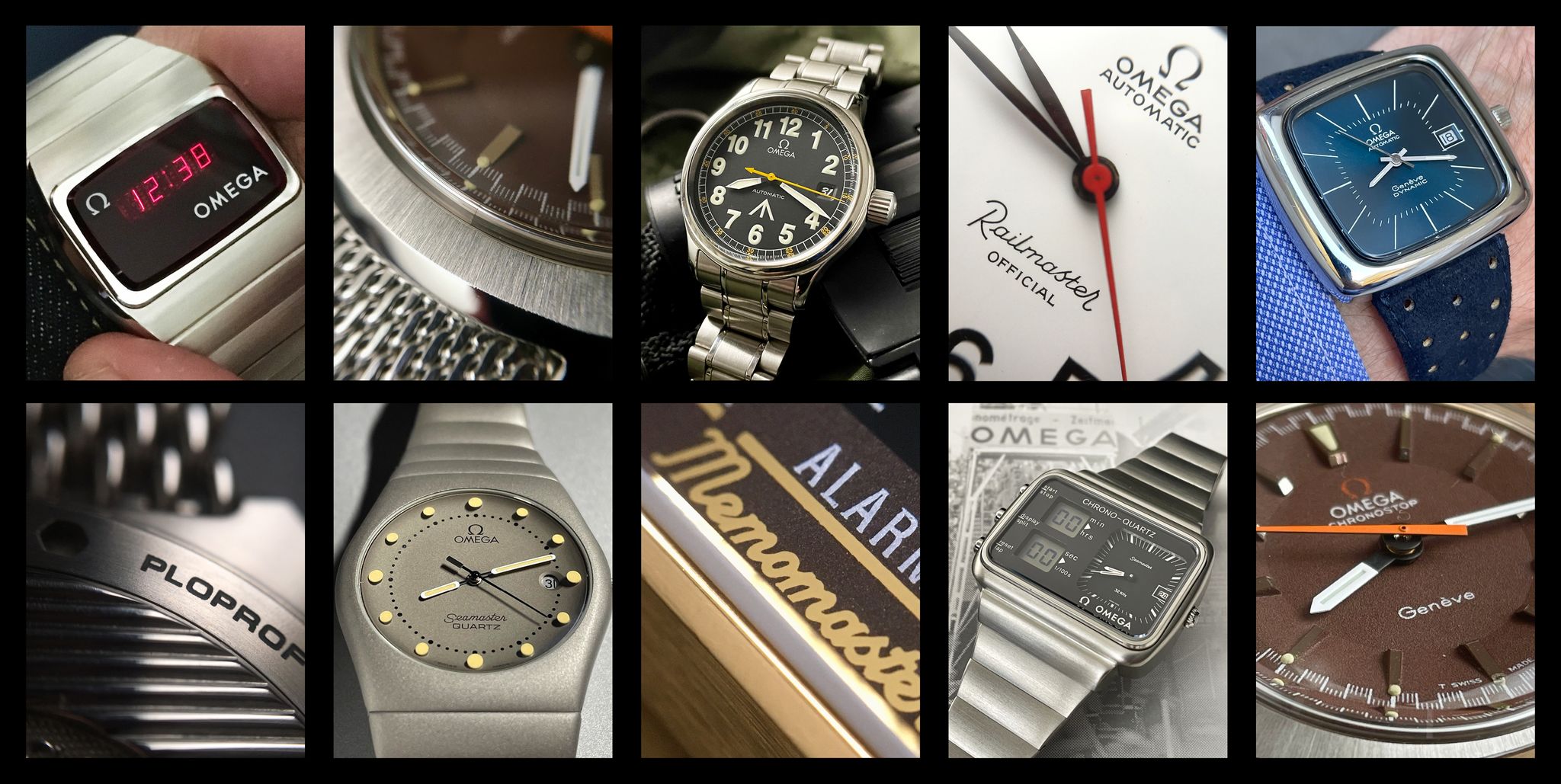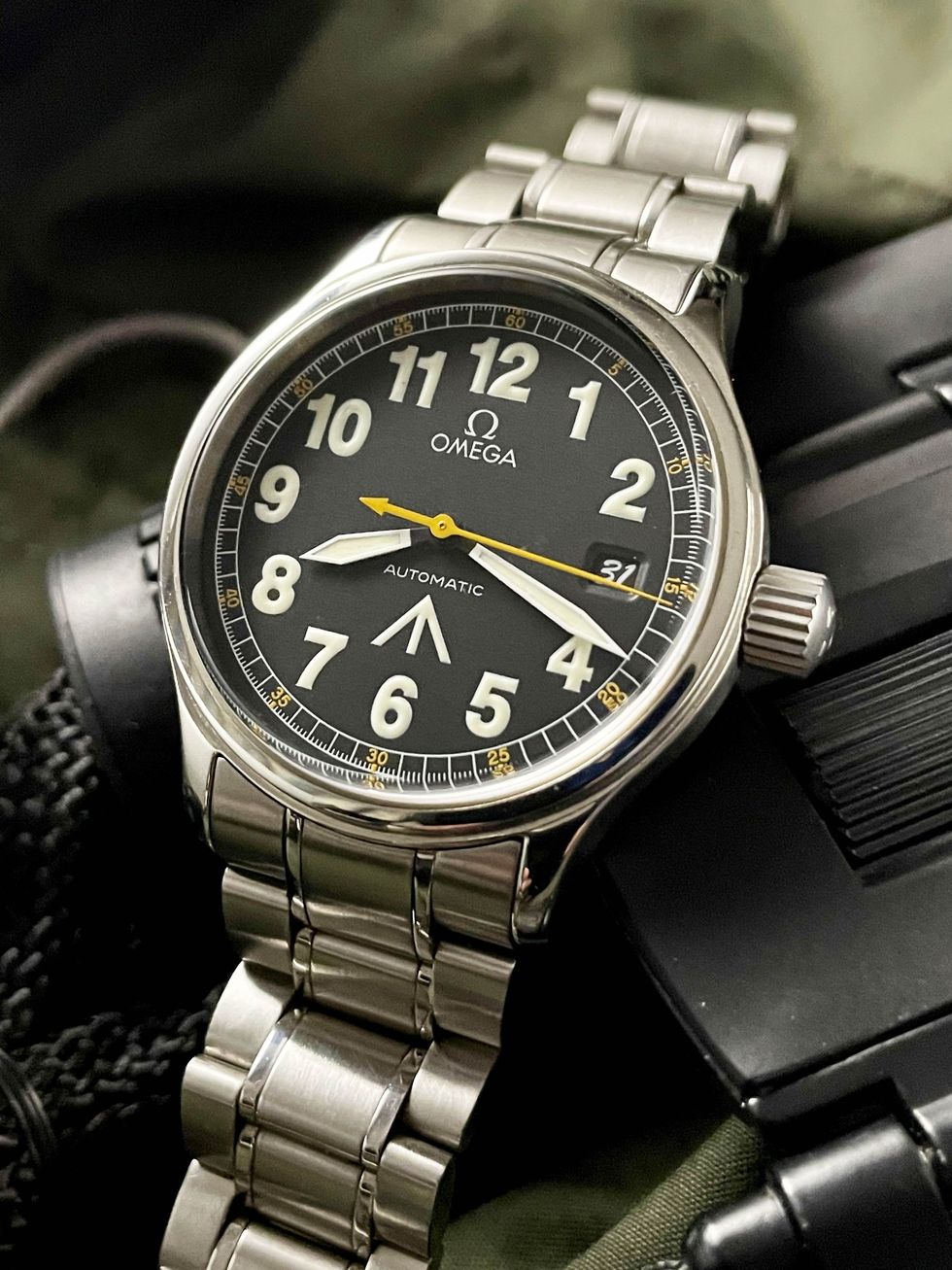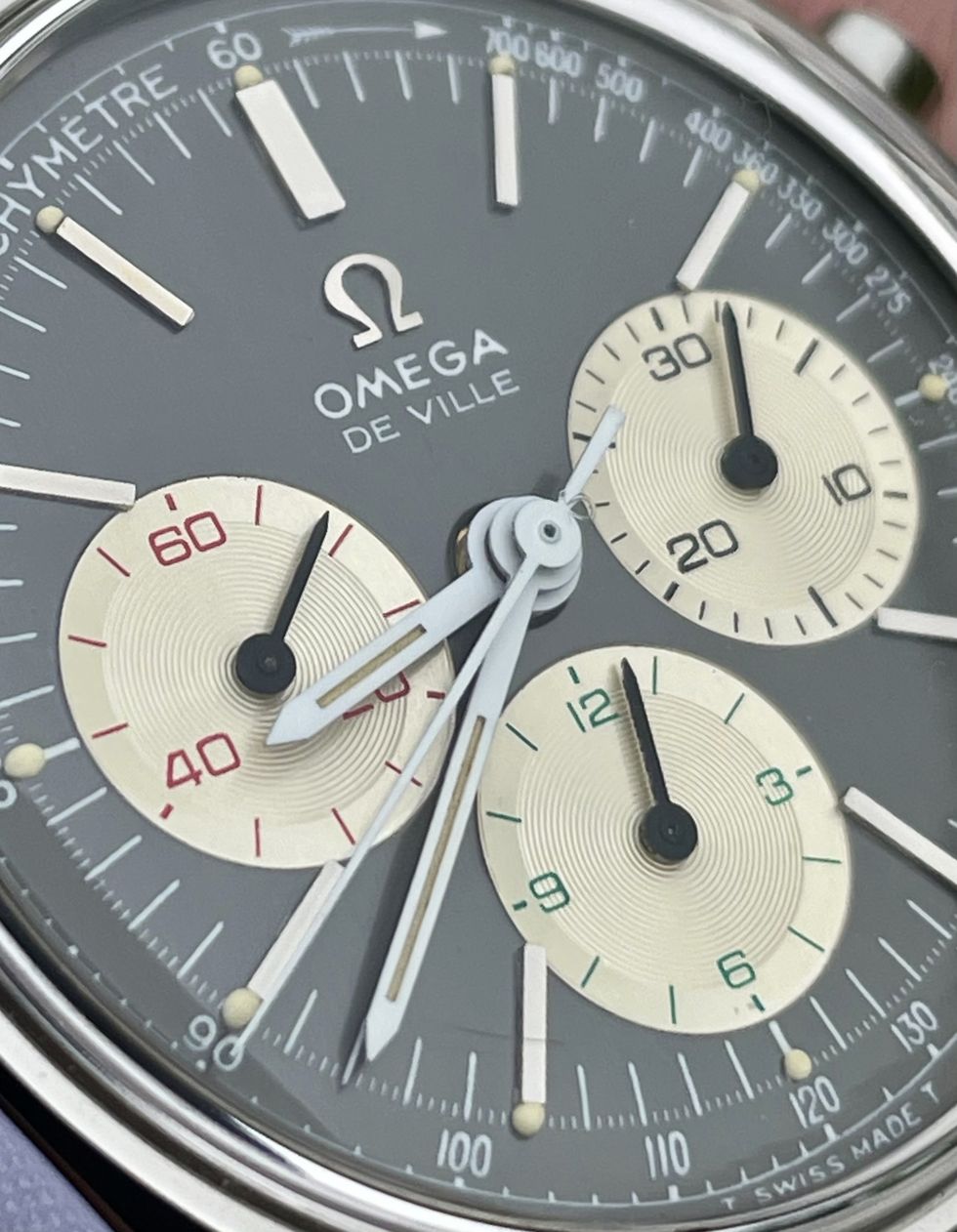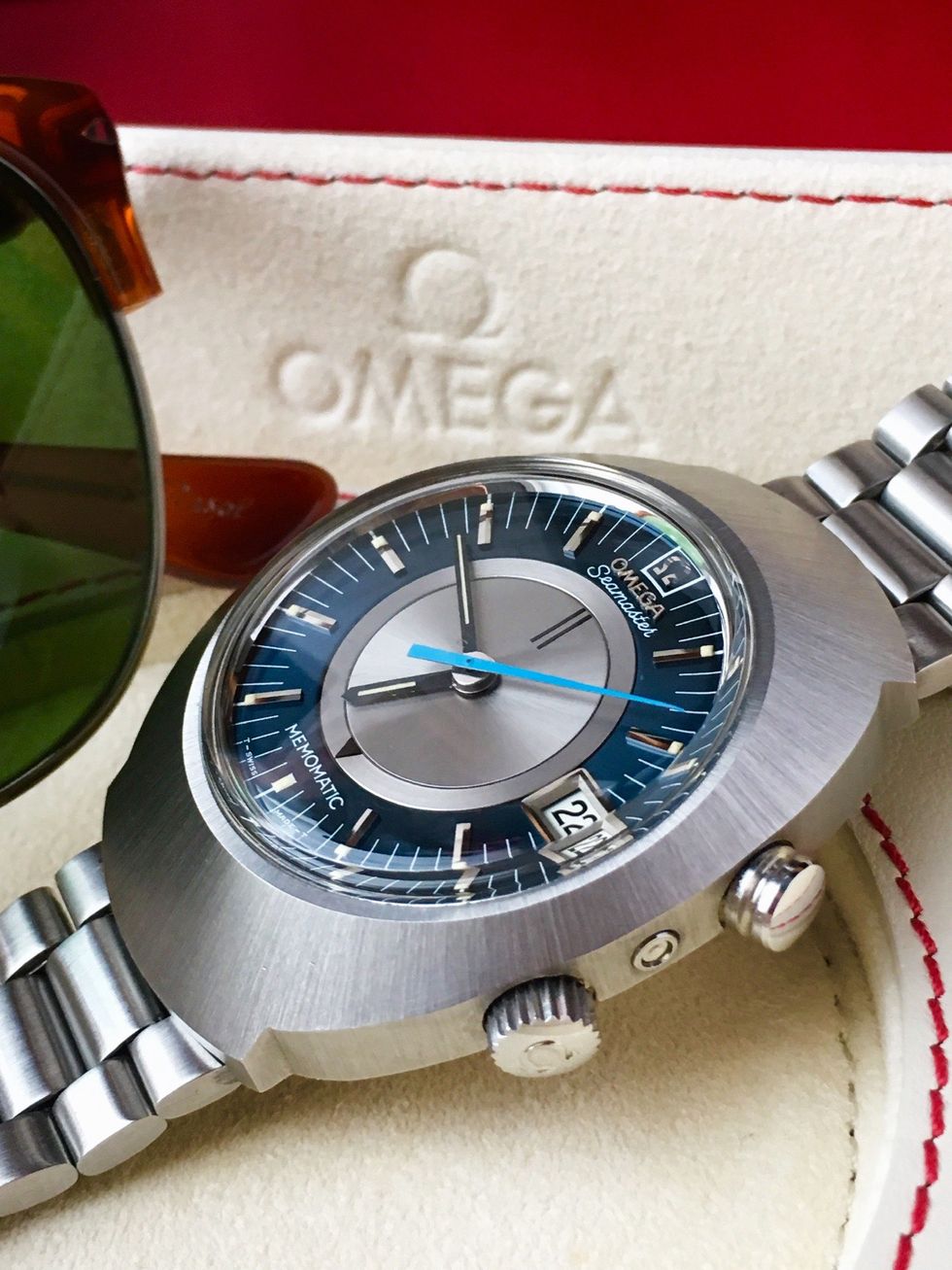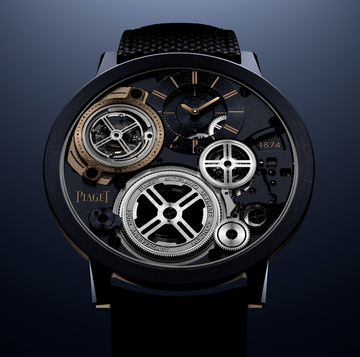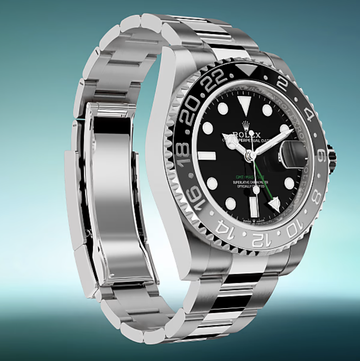If you had happened to be walk along London’s Jermyn Street one day in May 1970, you might have bumped into a crowd of young, fashionable men and women waiting outside Andrew Grima’s shop at No. 80. Grima was a celebrity jeweller, an Anglo-Italian whose radical, modern designs had made him an 18-carat fixture of Swinging London.
His shop, with its arty steel-and-slate exterior and Perspex spiral staircase, was a hip interloper on the street of stuffy gentleman’s tailors, but even so, its prices meant it rarely attracted what you’d call crowds.
In May 1970, however, Grima was exhibiting something special. About Time was a collection of 55 watches created with Omega, the Swiss watch company, recreating the extravagance of luxurious 17th-century. timepieces. Substituting thin slivers of semi-precious stones for watch glass, and using highly adventurous shapes, Grima had succeeded. The collection had been launched at Goldsmiths’ Hall in London in the presence of Princess Anne, shown there for three days, and then transferred to Jermyn Street, attracting acres of press and onlookers.
“A work of art in its own right”, one contemporary critic wrote; “perhaps the most avant-garde collection of timepieces in the history of the watch,” a horology writer said in a review of a Grima monograph last year. About Time was Something To See, like Damien Hirst’s diamond skull in the 2000s, or Ai Weiwei’s Sunflower Seeds at Tate Modern in 2010-11. It was shown in the Swiss Pavilion at Expo ‘70 in Osaka, Japan and exhibited at major cities around the world for the next. four years. As each watch was sold, it was, in most cases replaced by a new design, ensuring the lasting rarity of the pieces.
Such acclaim and monetary worth ought to have given the Grima-Omega collaboration a prominent place in recent watchmaking history. At the time Omega credited it with helping to transform their ranges. “Grima’s watches are the boldest and highest expression of our jewellery collection,” explained their 1972 sales guide booklet. “They have opened new horizons for us, and their influence is felt even on our most ‘commercial’ models.”
About Time is rarely if ever mentioned now. Most people would be surprised to see ‘Omega’ and ‘avant-garde’ in the same sentence. The Swiss behemoth today is a model of solid, dependable good practice, with its own reliable and distinct styles, but from the mid-1960s to the late-1970s, Omega released a series of watches that were distinctly experimental and outlandish. Most of them tend not to feature in the company’s official histories, but they nevertheless command a cult following. Interest in them has grown in the last five years as, Omega fan and founder of Bamford Watch Department George Bamford suggests, “collectors’ tastes have shifted towards microniches, micro-brands, and the weird and wonderful.” And if avant-garde Omega was about anything, it was about the micro-niche.
“You have to understand,” says Petros Protopapas, owlish director of the Omega Museum in Biel, Switzerland, “that Omega doesn’t stop. It never did.” Standing beside the 19th-century workbench of Louis Brandt, the Omega founder, Protopapas is explaining the company’s foundational principle: rather than buy parts from third-party manufacturers, Omega always designed its own. True, to do this, it bought up some smaller suppliers, but still. While some Swiss brands had to buy in someone else’s idea of a nice case, face, hands and so on, Omega could do their own (other brands also use this vertically integrated production model). This meant, says Protopapas, “that Omega could start with an idea, ask what they wanted to say, what they wanted to achieve, and then ask how they could realise that idea in watch form.”
Protopapas is standing in the spectacular Omega museum, part of the La Cite Du Temps, the campus of the Swatch Group, of which Omega is a part, in Biel. It takes up a single floor of a newish steel-and-wood building and is dominated by three themes in which Omega has a key part: James Bond movies, the Olympic games and the US space mission. Here and there, though, are timepieces from that experimental 1960s and 1970s period: the enormous Ploprof diving watch, the 1969 Flightmaster that looks like a prop from 2001: A Space Odyssey, the 1976 analogue-digital Seamaster Chrono-Quartz that echoes the Montreal Olympics scoreboard of the same year. In the museum, functionality tends to be stressed over historical context, but spend time away from Bond and the space tech and another story emerges.
Omega, founded as Le Generale Watch Co in La Chaux-de-Fonds, Switzerland by Louis Brandt in 1848, became notable for the practical watches and timepieces it made for, among others, the Olympic Games and Allied forces in World War II. But there is also aheritage of more decorative and experimental design: its extravagantly decorated 1896 gold Greek Temple pocket watch, caused a sensation when it won a Grand Prize at the 1900 Universal Exposition in Paris.
As a museum display case makes clear, Omega’s modern era begins in 1957 with the “holy trinity” of tool watches: the updated Seamaster (300), the Speedmaster and the Railmaster. Built for diving, timing and resisting electromagnetic fields (especially useful for railway workers), it is an early example of a “family” of watches and of a watch company presenting a vision of its users with different needs. Still the foundation of Omega’s product line, it is rightly hailed as a market innovation under Joseph Reiser, who took over as CEO in 1955. But there’s more to it than that.
“There was, going back a long time, a commitment to freedom and cooperation between individuals in the company,” says Protopapas. “Even in World War II, when Switzerland was surrounded by Axis forces, and many Swiss companies were pressured into making equipment and arms for the Axis, Omega resisted. We never made anything for the fascist forces, only for the Allies, including the British army. “Coming out of that, there was a strong sense of needing to build things for a new future. Of thinking how the future should be to ensure we never go back to that dark time. When we provided the timekeeping at the Olympics in 1948, it wasn’t just about the timing of sport, it was about a return to a new, peaceful normality. The Olympics was an image of happiness and positivity, and we were thinking about how timekeeping is a part of that. That’s partly why the Seamaster was invented that same year.”
In this telling, the trinity becomes a realised modernist vision of tools for building the new post-war Jerusalem; tools for a new world in which mankind would go further, faster and more efficiently in the name of progress and adventure. By the 1960s, that progress and adventure had extended to hitherto impossible exploration, such as the moonshots and the descent into the Mariana Trench, and to the aesthetic and sensory. Following both paths, Omega ventured to new extremes in terms of style-led and tool-oriented watches, sometimes bringing the two together in the likes of Grima’s watches and the Flightmaster and Ploprof.
The aesthetic – what Protopapas calls the “pure design” – experiments led to collaboration with people like Grima, but also found their way into watches for general consumption. In 1967, Omega had a more fashion-led, lower-priced range called Genève aimed at younger consumers. Proof that Swatch didn’t invent the idea of playful, novel watches, the Genève line produced delights such as the round-cornered square Automatics, the chunky stainless-steel starter-chronograph Chronostop, and the oval Dynamic. The latter, with the blue face, silver concentric circle and big day-date window, is a lovely, lowlevel model still widely available and as redolent of the early 1970s as Ziggy Stardust and Chopper bikes. An overlooked part of Omega history, Genève was a significant success; by the time it ceased production, the collection made up 60 per cent of Omega’s total sales.
Such adventures in style were not restricted to the top end and the entry-level ranges. By 1975, even the Speedmaster was getting an extreme transformation with the 1045 “TV dial” model, now one of the most well-loved and collectable Speedies. The chronograph featured central second and minute counters, a day-date complication, a 24h indicator and extreme reliability, which is what one would expect. However, while Speedmasters tend to have a round, black dial as default, this one got a sunburst blue dial and two-colour hands. It also uses the heavy bar-bracelet of the celebrated earlier Speedmaster 125, making it chunky and conspicuous on the wrist.
Like so many of the great pieces from this period, it was a beautifully uncompromising experiment, with no real reason or pretended need, except the delight of a new take. “It’s what I love about these Omega watches from the 1970s, says George Bamford. “There’s no hesitation, just a sense of, ‘Well, why not do it? We’ll create this and see what happens.’You can see the freedom the designer had, unlike today, when people are designing for markets. [Back then] I think designers could say, ‘Hey, we’re gonna do this! And the salesman would have to sell it.’”
Now that the popularity of tool watches makes function all-important, and restrained good taste is a mass-market lifestyle option, the decadent, mickey-taking daftness of some of Omega’s period offerings feels rather refreshing. The Constellation Megaquartz “Stardust” from 1974, with its glittering face, is surely the most disco watch ever made; the Seamaster Recife, a last-gasp for such playfulness in 1984, perfectly evokes, as one commentator says on the Instagram feed of vintage Omega collector Stephen McKee (@steviemac1040), “scoring coke with Don Johnson on the set of Miami Vice and you go see Beverly Hills Cop and then hit the club and score more coke.”
The apogee of such excess is sometimes thought to be the gold Flightmaster from the 1970s, the first of which was delivered to King Hussein of Jordan and, at over a quarter of a kilo, one of the heaviest watches ever made. However, even this is surely topped by the legendary La Magique, the watch worn by Al Pacino as Tony Montana in the 1982 film Scarface. Then one of the thinnest watches ever made, at 2.6mm, the La Magique replaced conventional hands with two ultra-thin glass discs with hands marked on them with gold dust. The quartz movement was placed off-centre and with nothing behind it, the centre of the face was left transparent, the wearer’s skin forming the background. It’s incredible, and you’ll probably have to watch Scarface if you want to see one; only 261 were ever made.
The other extreme to this exquisite wrist candy was a series of tool watches, some of which are well known, while others deserve a greater following. The ultimate is Speedmaster Alaska II, an influential prototype designed as part of the perhaps the most demanding tool-oriented project in horological history, Omega’s Nasa collaboration of the 1960 and 1970s. In 1962, astronaut Wally Schirra wore his own watch, a second-generation Speedmaster, on the Mercury-Atlas 8 mission, marking Omega’s debut in space. Three years later, Nasa chose Omega as its official watch supplier, and in the late 1960s, together began to develop a model designed specifically for space travel. The challenge was to turn the Speedmaster into a proper Space Watch that worked in extremely hot and cold temperatures and that could handle the demands (varying pressure, low visibility, lots of knocks) of a flight and landing. Led by Omega chronometer designer Pierre Chopard, the Alaska Project produced several prototypes, featuring a new white dial and more legible hands, and a bulky case made from titanium (a first in watchmaking) to reduce weight and temperature conductivity.
The most noticeable change, however, was the addition of an oversized red anodized aluminium cover to protect against temperature variations (anodized aluminium has very low thermal conductivity, and red absorbs more heat and radiation that any other colour). Neither this Alaska nor any of the other variants went into production – at least not at the time. Several of its innovations did show up in 1969 in the Speedmaster Mark II (and later the Mark III and Mark IV), a watch that would strongly influence what we now think of as typical Seventies watch design. It was one of the fi rst to use the “egg” shape, and to have a large, smooth exterior with integrated lugs – a design choice rooted in the need to minimise the snagging potential for astronauts.
You can see the trickle-down effect in the shapes of some mid-1970s Genève models. An Alaska Project watch was released in 2008, complete with red aluminium cover – perhaps the only watch ever reissued without having ever being issued in the fifst place.
“With what was going on at Nasa,” says Protopapas, “there was so much spirit of adventure in the 1960s, and people at Omega were conscious of being connected to it. The new challenges they faced drove the design innovations, from colour combinations, to checkerboard patterns to cases and straps. And with this new sense of spirit, the brand made itself known as a place where you could try things out. There was an open invitation to designers and other people with ideas.”
One such man of ideas was Frédéric Robert, a French scuba diver and sailor who founded a watch company called Aquastar in Geneva in 1962. The focus and simplicity of Aquastar’s diving and sailing watches were widely admired, and in 1967, he joined Omega, where for several years he designed all of its sports-oriented watches, including those for diving and flying. Robert brought a genuine insight into users’ needs, and in applying that gave his watches an added authenticity. His lasting contribution to the diver’s watch was the shift in emphasis from hour hand to minute by adding size and bright colour to the latter: divers, as he knew, think in term of minutes, not hours.
Robert was responsible for several iconic designs. The 1968 Seamaster Soccer Time is a favourite among collectors, partly for its quirky solution to solving the problem of timing 45-minute halves by adding a “45” on the outside of the sub-dial. It kicked o a new chrono-genre that would lead to new iterations with a wonderful “roulette” bezel, and the Referee’s watch for FIFA in 1979, which used an Alaska model case. Only 60 were made, but it is among the most attractive football watches, its 45-minute period picked. out with a smart orange internal bezel.
There is disagreement about Robert’s masterpieces. Protopapas believes it was the Flightmaster, a pilot’s watch, which built on Omega’s reputation as the supplier of cockpit instruments to Concorde. “Because while it might look like almost an overkill version of late 1960s design, it’s based on the idea of beautiful functionality. The other pilotswatches” – he means Breitling, but is too tactful to say – “were complex, and provided more than pilots really needed. You know, what were you supposed to do, use bezels to time your five minutes to landing? Robert designed to fulfi l pilot’s real needs, and he was very skilful with the use of colour. And it worked. All the Concorde pilots wore them.”
For everyone else in air travel’s glamorous golden age, a Flightmaster on your wrist was the closest thing to going supersonic. From the point of view of the watch fan, says George Bamford, the timepiece de resistance has to be the famous giant Seamaster Ploprof (from the French plongeur professionnel, or professional diver) diving watch.
The excitement around deep-sea diving is forgotten now, but in the 1960s advances in technology were making it possible to explore the world under the water as well as the skies. This is the time of growing interest in sunken wrecks like the Titanic, the use of police frogmen, scuba sequences in action films like Thunderball. The Ploprof, designed to withstand then extremely high pressures, was a response to that, but it also had a sort of sheer exuberance about it.
“It’s probably my favourite Omega of that time,” says Bamford. “I just like the badass size of it, it just makes me smile. I like the way all the movement comes from the crown – there’s no messing about at the back of the watch, everything’s from the front. It takes all the other diving watches of that time, that whole thing, takes the mickey out of it. There are some other crazy Seamasters from that time but this one: you can’t help but like it.”
The Ploprof, along with the Alaska Project and the “Bullhead”, a Speedmaster chrono with the crown repositioned to 12 o’clock to better suit rally drivers, is one of the unusual models that Omega reissued last decade. They attracted some attention at the time, but Bamford thinks, “they were killer designs, but it might have been too soon, because watch collecting has changed a lot in the last four or five years. Luxury has become mass-market, there are so many nice watches you can buy, but then you end up standing next to someone with the same thing. So now people are collecting more niche watches, micro-brands, unusual pieces, because they can reflect a more individual, personal taste. And people like the weird and wonderful 1960s and 1970s watches because they come out of a time when watch companies took more risks. Nowadays there can be a sense of the marketing department being a tail that wags the whole company, dictating to the designers. I’d certainly be in the queue if Omega to start reviving more of its own weird and wonderful work. Especially some of the quartz models.”
Ah, quartz. We were bound to end up here, weren’t we? The story of Omega and the quartz crisis after 1975 is well known. Reeling from the onslaught of cheap Japanese quartz watches, Omega’s owner SSIH was rescued by the banks in 1981, and merged with the other Swiss watch conglomerate, ASUAG, in 1983. Renamed SMH, the new group saved the Swiss industry with the Swatch, and became one of the top producers in the world. It also established a new model for modern Swiss watch brands with the remarketing of Omega based on strategic product placement and advertising, streamlined ranges, and a focus on heritage models.
This focus on classical movements and heritage overlooks the excitement and optimism there once was around quartz watches in Switzerland. From the 1950s, Omega was part of a consortium of Swiss makers competing with the Japanese and Americans to be first to market with a quartz model. In 1969 Seiko beat them to it, but Omega followed a few months later with the first commercial Swiss quartz watch. The Constellation Electroquartz took the Beta-21 movement developed by the consortium and housed it in a chunky, wedge-shaped case of either gold or stainless steel. The sci-fi tinged futurism that attached itself to quartz watches was clear in its looks and would be present in many Omega quartz watches – and their owners – for the next decade. The energy and exuberance of the period, the sort of thing that would come to be seen as 1970s inefficiency, is evident in the fact that by the end of the 1970s, Omega had more than 2,600 models in production; it now has about 80.
Again, there were brilliant tool watches and spectacular pure design pieces. The 1974 Marine Chronometer showcased the extraordinary precision achievable by quartz in a rectangular chunk whose uncompromising size and shape made it clear it was a serious machine. Meanwhile the 1973 Time Computer, Omega’s first foray into LED, helped to define the slick minimalist style of early digital. This was briefly a very fashionable piece: Mick Jagger had one, Terry Savalas wore one as Kojak and Keith Moon bought one for Ringo Starr as a present. The Time Computer has a strange, contradictory beauty today, now we know that digital technology turned out to be disposable and cheap; the solid gold casing and Omega’s branding on it seems an almost poignant evocation of a different time and place. The Constellation LED of 1975 is slicker, considered by some to be the best-designed Omega digital, and the Megaquartz range is more collectable, being some of the most accurate wristwatches ever made, but the Time Computer has a naive, jolie-laide quality to it. It’s a reminder that something doesn’t have to be timeless and classic to be meaningful.
“Everything today is evolutionary, rather than revolutionary,” says Stuart Solomons, who runs the website Omega Passion and has collected Megaquartz for over 40 years. “It’s a better iPhone, a better laptop. The thing about the Megaquartz 2400 was that it was utterly revolutionary, an absolutely huge change in what a watch was capable of doing. It is still the most accurate, non-thermocompensated watch [in quartz watches theromocompensation is a way of countering temperature fluctuations and maintaining accuracy] in the world, today. No piece of technology that has emerged since then has surpassed it.
“Every single serious watch collector, and I don’t say this lightly, because I am a serious watch collector, should have an Omega Megaquartz in their collection. For sheer precision it’s an astonishing piece to own. There’s no other watchmaker that made the contributionto watchmaking Omega made in the 1970s. Nobody even came close.”
Omega’s quartz movements would also yield beauties like the La Magique, before the cheap watches from Japan brought an end to their manufacture and, indeed, to the postwar vision at Omega; it would recover only by learning to market its past as well as the future. It is worth remembering that while the success of Swatch now tends to make us think of the more senior brands as bastions of classic good sense with a certain conservatism, there was a time when Omega was anything but. In fact, looking back at avant-garde Omega, it’s possible to imagine a sort of parallel universe in which the quartz crisis never happened, and Omega’s experiments created their own revolution.
Consider the 1970 Genève Dynamic with its face of concentric circles, the 1974 Constellation Megaquartz “Stardust” with its glitter, and the 1984 Seamaster Recife, with the face, case and strap all made of the same grey oxidised steel. In cheaper plastic, couldn’t these have been Swatches? Could it be that when Omega experimented with its playful, lower-priced, fashion-led Genève range, it was inadvertently reaching towards a future that wasn’t quite ready to be born?
Maybe the truth is simpler. As George Bamford more succinctly put it: “Omega watches from the 1960s, 1970s and early 1980s? Just cool. So damn cool.” Whatever the reason, it might well be time for this particular kind of time’s second coming.
Taken from the 2021 edition of The Big Watch Book, put together by the team behind Esquire.
